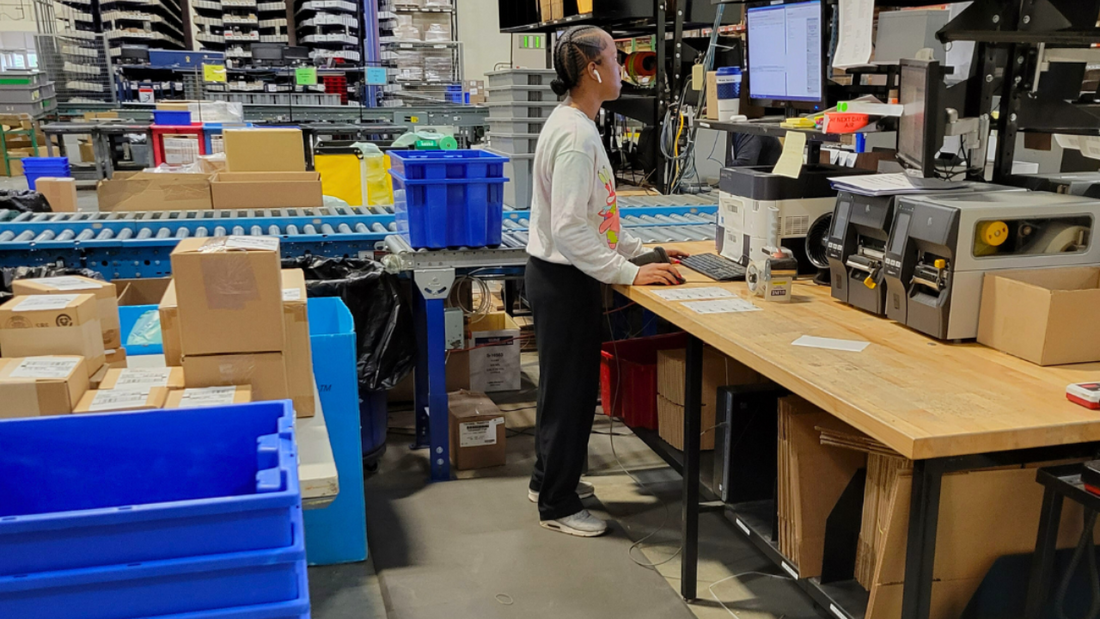There is a right way and a wrong way to trial anti-fatigue mats. The wrong way can lead to wasted time and money, mats that curl and break down quickly, and frustrated employees. The right way can protect your time, budget, and people for years at a time.
Here are 5 key steps when sampling anti-fatigue mats
1. Sample the mats in production
We surveyed several hundred safety and production leaders throughout 2023. 52% say they expect their anti-fatigue mats to last at least 2 years; only 32% say they actually are. Worse, 48% say their mats are lasting less than a single year:

One reason your mats aren’t lasting as long as you expected? Lack of research on the front end – i.e., you’re not sampling anti-fatigue mats on the production floor.
5 Dos and Don'ts:
DON'T lay mats in the cafeteria for operators to stand on for 5 minutes during lunch breaks.
DON'T put mats in breakrooms or entryways for brief walk-by trials.
DON'T put mats in your office and call operators in 1-by-1 to quickly stand on.
ALWAYS trial sample mats on the production floor.
ALWAYS introduce the mats to the harshness of your environment.
In brief, the most comfortable mat is worthless if it doesn't actually hold up in your environment – if it doesn’t endure oils, chemicals, fiberglass shavings, sawdust, 24 hours of use, and frequent cleanings. You won't get that information in an office setting.

Nokian Tyres trialed a free custom anti-fatigue sample mat from AcroMat for several weeks, in production, before making any buying decisions. The extended trial allowed the team to know exactly what they were investing in.
2. Sample mats for weeks or even months
In addition to trialing mats in the areas they will be used, make sure to give every sample adequate time in your production environment. We recommend at least 200 working hours.
If you’re undertaking a large mat project – say, turning over all mats across your facility – you might want to double this time period. Every “premium” anti-fatigue mat will last ~6 months. It’s how they hold up from this point on that matters to your people and your bottom line.

These welding anti-fatigue mats for an air compressor manufacturer began curling less than 1 week into production – rendering the mats worthless after thousands of dollars were spent and putting them back at square one.
Let your sample mats get wet, dirty, dusty, and stomped on with heavy boots. Expose them to the oils, chemicals and products you use every day. You need mats that will keep your workforce safe and comfortable for years at a time. Not something that looks nice for a couple days but curls a few weeks later.
3. Never invest without operator feedback
During a recent site visit to help a solar panel manufacturing company make informed buying decisions, the EHS supervisor said one mat was far and away more comfortable than the others. We then asked an operator who stands 8-10 hours each shift, 5 shifts a week:
"It's too soft, my ankles feel like they're sinking."
While feedback from all sides is helpful, it’s important to get honest, genuine feedback from the people who will be standing on the mats every day. You can get important information with simple questions like:
✅Do you feel safe and physically supported?
✅Has your mat been sliding around or curling?
✅How do your feet/back/neck feel after each shift?
✅How is the mat holding up to liquids and chemicals?
✅Do you have pains you can't connect to an impact injury?
✅How does this mat compare to what you have been using?
4. Consider comfort surveys.
If you're undertaking a BIG mat project, rather than just a single workstation, comfort surveys can provide valuable feedback. “But only if they're done right," says Ergonomist Mary Plehal.
According to Mary, there are 5 keys to a good comfort survey:
✅Explain the purpose of the survey (your hopeful outcome)
✅Conduct the survey in person away from production
✅Organize by body part (e.g., lower back and feet)
✅Have pre-planned improvement in the works
✅Re-administer the survey down the road
In person is especially key.
"Bring employees into a breakroom or conference room," says Mary. "This avoids distraction, surveys being dismissed, and helps makes sure nothing is lost in translation."
Ergonomist Mary Plehal breaks down the 5 keys to a good comfort survey in just 5 minutes.
5. Make sure the *free* sample is big enough to stand on
Every sample should be big enough to stand on with both feet – at least 12 in. by 12 in. Depending on the size of the overall mat project, you likely need something bigger or even a custom shape.
If the anti-fatigue mat providers you are considering partnership with are expecting you to make critical buying decisions with 1 in. by 1 in. squares smaller than your hand, it's time to look elsewhere.

Left: Box of "samples" we received from competitors and suppliers; 1-2 in. squares, not nearly big enough to actually trial. Right: Free custom sample mat AcroMat made for a multinational aerospace manufacturer. Every sample should be big enough for your team to actually experience the benefits being promoted.
--
Interested in comparing an AcroMat to what you're currently using?
Request a free sample mat here, standard or custom
Take this content with you with our freely available, downloadable and printable eBook:
